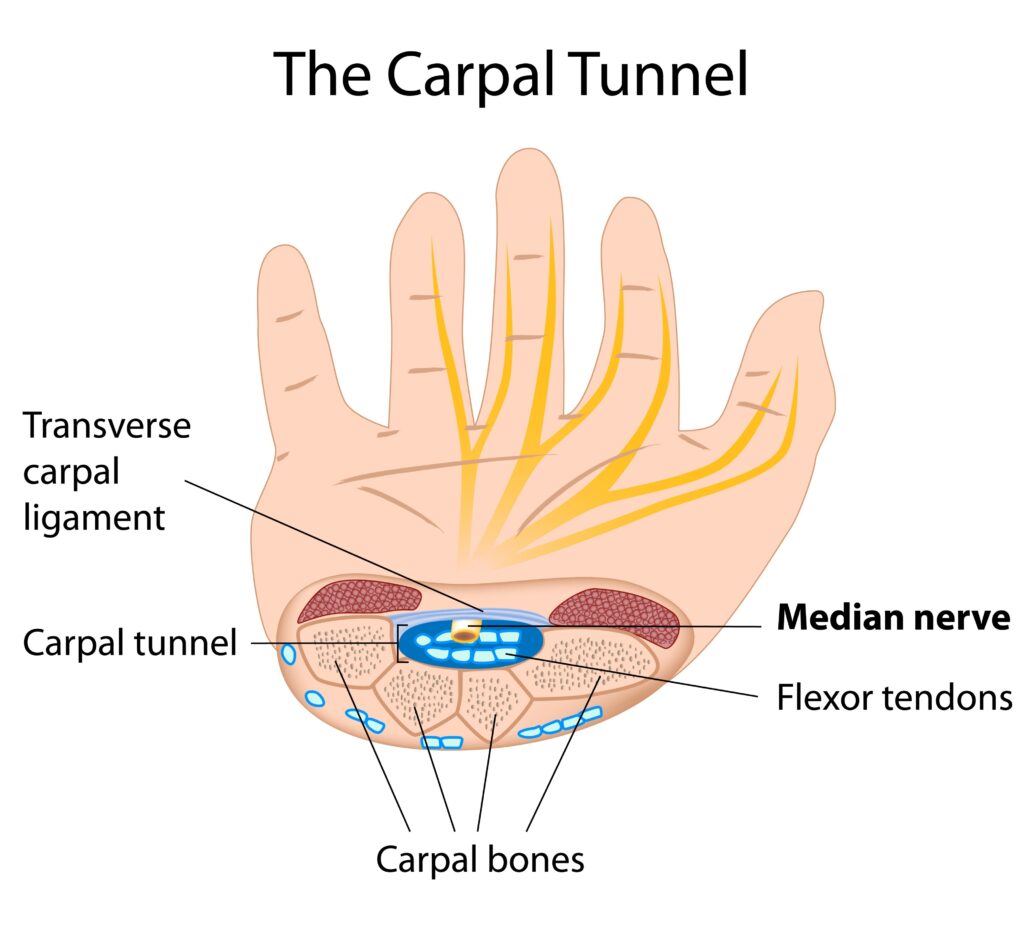Brooklyn, NY 11212
24/7 Customer Support
• Carpal tunnel syndrome is caused by irritation of the median nerve at the wrist.
• Any condition that exerts pressure on the median nerve can cause carpal tunnel syndrome.
• Symptoms of carpal tunnel syndrome include numbness and tingling of the hand.
• Diagnosis of carpal tunnel syndrome is suspected based on symptoms, supported by physical examination signs, and confirmed by nerve conduction testing.
• Treatment of carpal tunnel syndrome depends on the severity of symptoms and the underlying cause.
Carpus is a word derived from the Greek word karpos, which means “wrist.” The wrist is surrounded by a fibrous tissue band that generally functions as a support for the joint. The tight space between this fibrous band and the wrist bone is called the carpal tunnel. The median nerve passes through the carpal tunnel to receive sensations from the thumb, index, and middle fingers of the hand. Any condition that causes swelling or a change in position of the tissue within the carpal tunnel can squeeze and irritate the median nerve. Irritation of the median nerve in this manner causes tingling and numbness of the thumb, index, and the middle fingers — a condition known as “carpal tunnel syndrome.”

The choice of treatment for carpal tunnel syndrome depends on the severity of the symptoms and any underlying disease causing the symptoms.
Initial treatment usually includes rest, immobilization of the wrist in a splint, and occasionally ice application. Those whose occupations are aggravating the symptoms should modify their activities. For example, computer keyboards and chair height may need to be adjusted to optimize comfort. These measures and periodic resting and range of motion stretching exercises of the wrists can prevent carpal tunnel syndrome symptoms caused by repetitive overuse. Underlying conditions or diseases are treated individually. Fractures can require orthopedic management. Obese individuals will be advised regarding weight reduction. Rheumatoid disease is treated with measures directed against underlying arthritis. Wrist swelling that can be associated with pregnancy resolves in time after the delivery of the baby.
Several types of medications have been used in the treatment of carpal tunnel syndrome. Vitamin B6 (pyridoxine) has been reported to relieve some symptoms of carpal tunnel syndrome. However, it is not known how this medication works. Nonsteroidal anti-inflammatory drugs can also help decrease inflammation and reducing pain. Side effects include gastrointestinal upset and even ulceration of the stomach. These medications should be taken with food, and abdominal symptoms should be reported to the doctor. Corticosteroids can be given by mouth or injected directly into the involved wrist joint. They can bring rapid relief to the persistent symptoms of carpal tunnel syndrome. Side effects of these medications, when given in short courses, for carpal tunnel syndrome are minimal. However, corticosteroids can aggravate diabetes and should be avoided in the presence of infections.
Most patients with carpal tunnel syndrome improve with conservative measures and medications. Occasionally, chronic pressure on the median nerve can result in persistent numbness and weakness. To avoid severe and permanent nerve and muscle consequences of carpal tunnel syndrome, surgical treatment is considered. Surgery involves severing the band of tissue around the wrist to reduce pressure on the median nerve. This surgical procedure is called “carpal tunnel release.” It can now be performed by microsurgery with a small diameter viewing tube, called an arthroscope or an open wrist procedure. After carpal tunnel release, patients often undergo exercise rehabilitation. Though it is uncommon, symptoms can recur.
By reading this website, you acknowledge that you are responsible for your own health decisions. The information throughout this medical website is not intended to be taken as medical advice. The information provided is intended for general information regarding Pain Management symptoms and services.
If you are interested in finding out more, avoid worrisome self-diagnosis, please contact our Pain Management specialist for a personal consultation. No information on this site should be used to diagnose, treat, prevent, or cure any disease or condition.